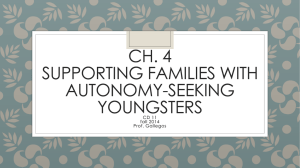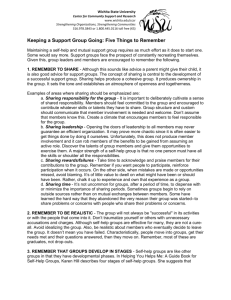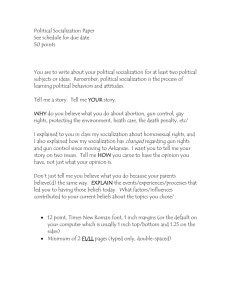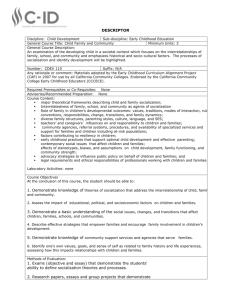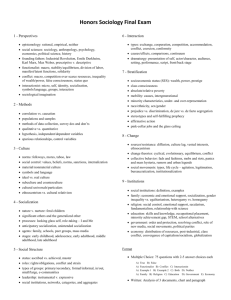Summary - Sophia University Private Home Page Service
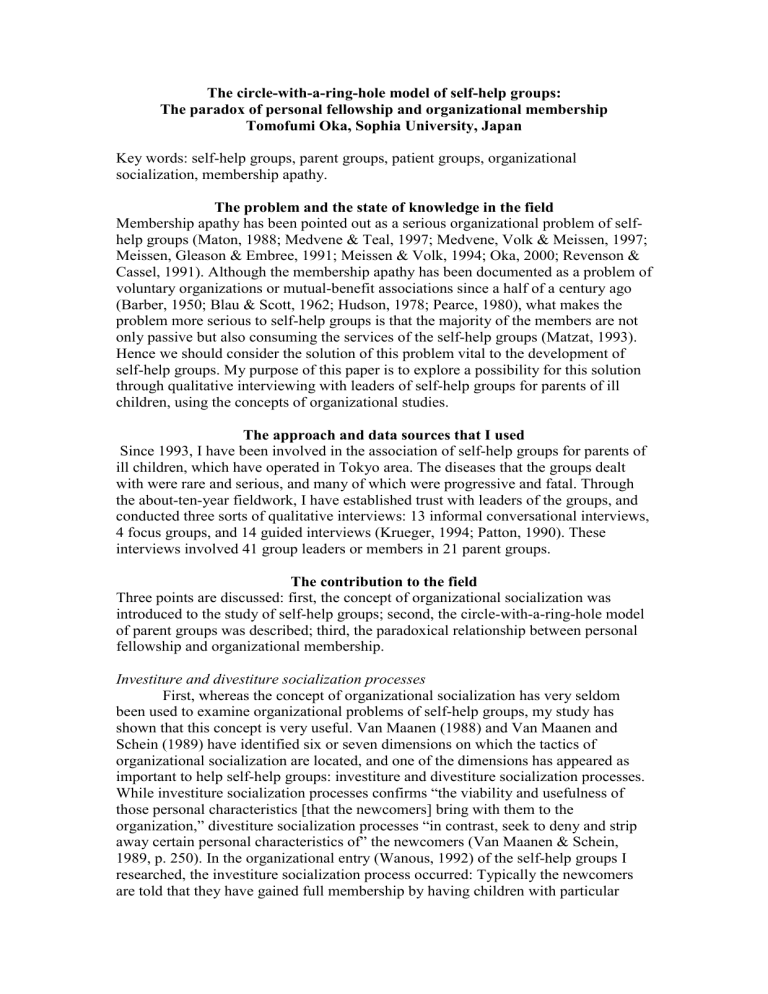
The circle-with-a-ring-hole model of self-help groups:
The paradox of personal fellowship and organizational membership
Tomofumi Oka, Sophia University, Japan
Key words: self-help groups, parent groups, patient groups, organizational socialization, membership apathy.
The problem and the state of knowledge in the field
Membership apathy has been pointed out as a serious organizational problem of selfhelp groups (Maton, 1988; Medvene & Teal, 1997; Medvene, Volk & Meissen, 1997;
Meissen, Gleason & Embree, 1991; Meissen & Volk, 1994; Oka, 2000; Revenson &
Cassel, 1991). Although the membership apathy has been documented as a problem of voluntary organizations or mutual-benefit associations since a half of a century ago
(Barber, 1950; Blau & Scott, 1962; Hudson, 1978; Pearce, 1980), what makes the problem more serious to self-help groups is that the majority of the members are not only passive but also consuming the services of the self-help groups (Matzat, 1993).
Hence we should consider the solution of this problem vital to the development of self-help groups. My purpose of this paper is to explore a possibility for this solution through qualitative interviewing with leaders of self-help groups for parents of ill children, using the concepts of organizational studies.
The approach and data sources that I used
Since 1993, I have been involved in the association of self-help groups for parents of ill children, which have operated in Tokyo area. The diseases that the groups dealt with were rare and serious, and many of which were progressive and fatal. Through the about-ten-year fieldwork, I have established trust with leaders of the groups, and conducted three sorts of qualitative interviews: 13 informal conversational interviews,
4 focus groups, and 14 guided interviews (Krueger, 1994; Patton, 1990). These interviews involved 41 group leaders or members in 21 parent groups.
The contribution to the field
Three points are discussed: first, the concept of organizational socialization was introduced to the study of self-help groups; second, the circle-with-a-ring-hole model of parent groups was described; third, the paradoxical relationship between personal fellowship and organizational membership.
Investiture and divestiture socialization processes
First, whereas the concept of organizational socialization has very seldom been used to examine organizational problems of self-help groups, my study has shown that this concept is very useful. Van Maanen (1988) and Van Maanen and
Schein (1989) have identified six or seven dimensions on which the tactics of organizational socialization are located, and one of the dimensions has appeared as important to help self-help groups: investiture and divestiture socialization processes.
While investiture socialization processes confirms “the viability and usefulness of those personal characteristics [that the newcomers] bring with them to the organization,” divestiture socialization processes “in contrast, seek to deny and strip away certain personal characteristics of” the newcomers (Van Maanen & Schein,
1989, p. 250). In the organizational entry (Wanous, 1992) of the self-help groups I researched, the investiture socialization process occurred: Typically the newcomers are told that they have gained full membership by having children with particular
diseases. Nevertheless, when they are required to become leaders, the divestiture socialization processes may occur: Some of my interviewees were told that the duty as leaders should take priority over the duty as parents. My study has suggested that this combination of investiture and divestiture socialization processes, as well as a complete absence of the selection processes of the applicants (Any parents can join the group) fosters the tendency of inactive majority of the parent groups.
The circle-with-a-ring-hole model
Schein (1971) has presented a three-dimensional model of an organization.
According to this model, the following three types of boundaries characterize the internal structure of an organization: hierarchical boundaries, inclusion boundaries and functional or departmental boundaries. Because the parent groups I researched had a strong ideology of egalitarianism and little differentiated role structures, which would negate the development of hierarchical and functional boundaries within the groups. Hence, the self-help groups are characterized by inclusion boundaries, “which separate individuals or groups who differ in the degree of their centrality (Schein,
1971, p. 405). If the inclusion boundary model is applied to the self-help groups, the groups will be described as a circle with a ring hole. This circle-with-a-ring-hole model means that the groups consist of two subgroups: active leaders and passive members, and there are few active followers that should be located between these two subgroups.
Personal fellowship and organizational membership
A factor that has maintained the circle-with-a-ring-hole model is the paradoxical relationship between “personal fellowship” and “organizational membership.” Personal fellowship refers to the resonance of people who have the same experiences, which has been considered the basis of every self-help group (e.g.,
Katz & Bender, 1976). The leaders of parent groups regard any parents who have children with the same diseases as their personal fellows. This personal fellowship might lead to an illusion that the newcomers need no elaborate or formal processes of organizational socialization. On the contrary, organizational membership, which includes enough knowledge of the nature of the self-help groups, should be given to the newcomers through elaborate tactics of organizational socialization. The confusion between personal fellowship and organizational membership should be resolved in order to reduce the inactive majority.
Conclusions
Although the inactive majority is a common problem of voluntary groups, the problem of self-help groups is more serious, because the inactive majority can be active consumers of the products of the self-help groups. The theoretical framework of organizational socialization helps clarify the structure of the problem: first, a combination of investiture and divestiture socialization might cause the absence of the medial subgroups between active leaders and passive members; second, the resonance of people with the same experiences might lead group leaders into thinking that the newcomers are not in great need of organizational socialization. Elaborate organizational socialization for the newcomers is recommended.
References
Barber, B. (1950). Participation and Mass Apathy in Associations. In A. W. Gouldner
(Ed.), Studies in Leadership: Leadership and Democratic Action (pp. 477-
504). New York: Harper and Brothers.
Blau, P. M., & Scott, W. R. (1962). Formal Organizations: A Comparative Approach.
San Francisco: Chandler.
Hudson, J. R. (1978). Maintaining Goals in a Mutual-Benefit Association. Journal of
Sociology and Social Welfare, 5 (3), 327-341.
Katz, A. H., & Bender, E. I. (Eds.). (1976). The Strength in Us: Self-Help Groups in the Modern World.
New York: New Viewpoints.
Krueger, R. A. (1994). Focus Groups: A Practical Guide for Applied Research (2 nd ed.). Thousand Oaks, CA: Sage.
Maton, K. I. (1988). Social Support, Organizational Characteristics, Psychological
Well-Being, and Group Appraisal in Three Self-Help Group Population.
American Journal of Community Psychology, 16 (1), 53-77.
Matzat, J. (1993). Away with the Experts? Self-Help Groupwork in Germany.
Groupwork, 6 (1), 30-42.
Medvene, L. J., & Teal, C. R. (1997). Leader’s Ambivalence About Reciprocity
Obligations in Self-Help Groups. Small Group Research, 28 (2), 302-322.
Medvene, L. J., Volk, F. A., & Meissen, G. J. (1997). Communal Orientation and
Burnout Among Self-Help Group Leaders. Journal of Applied Social
Psychology, 27 (3), 262-278.
Meissen, G. J., Gleason, D. F., & Embree, M. G. (1991). An Assessment of the Needs of Mutual-Help Groups. American Journal of Community Psychology, 19 (3),
427-442.
Meissen, G. J., & Volk, F. (1994). Predictor of Burnout Among Self-Help Group
Leadership. In F. Lavoie, T. Borkman, & B. Gidron (Eds.), Self-Help and
Mutual Aid Groups: International and Multicultural Perspectives (pp. 241-
262). New York: The Haworth Press.
Oka, T. (2000). The Free-Rider Problem and Organizational Messes in Self-Help
Groups: Justification, Accusation and Exposure Stories.
Presented at
Association for Research on Nonprofit Organizations and Voluntary Action
29th Annual Conference, in New Orleans, USA, on November 16-18, 2000,
Research Abstracts, B04.1.
Patton, M. Q. (1990). Qualitative Evaluation and Research Methods (2 nd ed.).
Newbury Park, CA: Sage.
Pearce, J. L. (1980). Apathy or Self Interest? The Volunteer’s Avoidance of
Leadership Roles. Journal of Voluntary Action Research, 9, 85-94.
Revenson, T. A., & Cassel, J. B. (1991). An Exploration of Leadership in a Medical
Mutual Help Organization. American Journal of Community Psychology,
19 (5), 683-698.
Schein, E. H. (1971). The Individual, the Organization, and the Career: A Conceptual
Scheme. Journal of Applied Behavioral Science, 7 (4), 401-426.
Van Maanen, J. (1978). People Processing: Strategies of Organizational Socialization.
Organizational Dynamics, 7 (1), 18-36.
Van Maanen, J., & Schein, E. H. (1979). Toward a Theory of Organizational
Socialization. In B. M. Staw (Ed.), Research in Organizational Behavior (Vol.
1, pp. 209-264). Greenwich, CT: JAI Press.
Wanous, J. P. (1991). Organizational Entry: Recruitment, Selection, Orientation and
Socialization of Newcomers (2 nd ed.). Reading, MA: Addison-Wesley.

